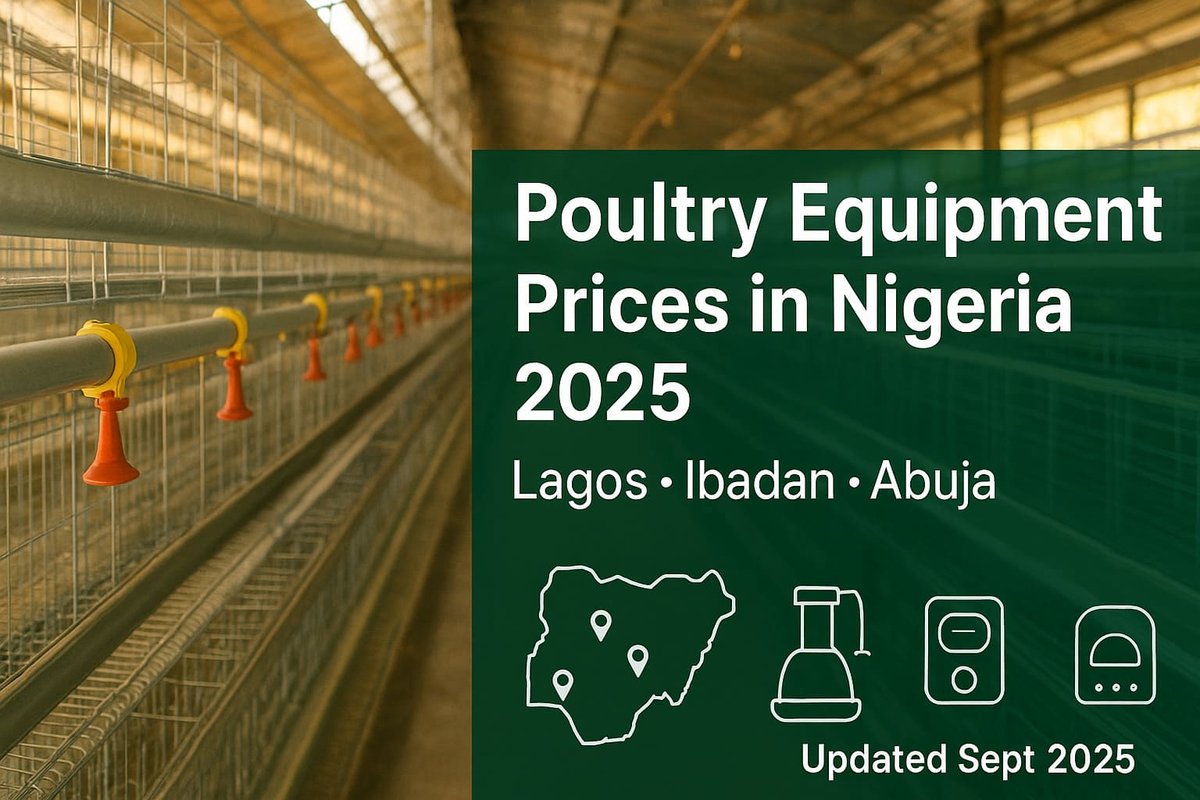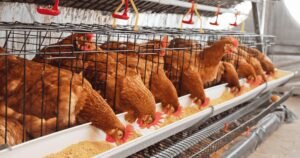Purpose: This guide helps Nigerian farmers choose durable, cost-effective equipment and accurately budget for their startup or expansion. I’m sharing everything I’ve learned to provide you with current, city-specific price data and practical, field-tested advice.
If you’re setting up or upgrading a poultry farm in Nigeria, you’ll need a clear list of essential poultry equipment and a realistic idea of poultry equipment prices for major hubs like Lagos, Ibadan, and Abuja. Believe me, I’ve been there. Getting started can feel overwhelming. This guide cuts through the noise to cover the essential tools of the trade—from feeders and drinkers to brooders, cages, and incubators—plus current price ranges by city.
I’ll also share my personal insights on how to choose the right capacity, what to buy new versus used, and where to find reliable suppliers for your poultry farm. Prices change with exchange rates and logistics, so we survey multiple sellers and update this page quarterly to ensure you have the most accurate information.
Health & Biosecurity Disclaimer: This guide provides general information on poultry farm management. For matters of animal health, disease prevention, or treatment, always consult a qualified veterinary professional, and consider guidance from the Veterinary Council of Nigeria (VCN). Biosecurity and health notes are educational; they do not substitute for professional veterinary advice.
Key Takeaways
- Battery cages cut feed wastage and dirty eggs for layers but cost more up front.
- In Lagos humidity, focus on ventilation and leak-free drinkers to reduce coccidiosis.
- Nipple lines + inline filter reduced our wet litter by ~40% in Ibadan.
- Gas brooders are more reliable where grid power is unstable.
- Prices vary by brand, capacity, and USD/NGN; verify before purchase.
Poultry Equipment and Their Uses
Understanding not just what to buy, but why and how to use it is the first real step to a profitable poultry business. Let’s break down the essential categories in detail.
Housing systems are the physical structures that provide a safe, controlled environment for your poultry, dictating bird welfare, space management, and ease of cleaning.
Housing Systems: Your Flock’s Foundation (Deep Litter vs. Battery Cages)
Your choice of housing is the single biggest decision affecting flock health, space management, and your day-to-day work. The debate of deep litter vs battery cage is central to this choice.
- Deep Litter System: This involves raising birds on a floor covered with 3-5 inches of absorbent bedding material like wood shavings litter.
- Pros: Lower initial capital investment, allows birds to express natural behaviours (scratching, dust bathing), which can reduce stress. It’s the standard for raising broilers.
- Cons: Higher risk of diseases like coccidiosis if litter becomes wet. Requires more labour for litter management and regular turning. Can lead to dirtier eggs if used for layers.
- Battery Cage System: Birds are housed in wire cages, usually stacked in 3-4 tiers. Manure drops through the wire floor onto trays or a conveyor belt.
- Pros: Excellent for space management and high stocking density. Results in cleaner eggs, drastically reduces feed wastage, and makes disease control and monitoring individual birds easier. This is the gold standard for commercial layers.
- Cons: Very high initial investment. Can lead to cage fatigue or skeletal issues in birds if not managed well. Requires more capital upfront.
- Field Note: In the high humidity of Lagos, managing wet litter is a constant battle, especially during the rainy season. On my first farm, we saw a ~15% drop in coccidiosis cases just by improving ventilation and ensuring our drinkers weren’t leaking. For layers, battery cages are almost always more cost-effective in the long run due to higher productivity and lower mortality rate. For those interested in egg production, understanding the specifics of a layer farming business Nigeria is a must.
Proper housing is your first line of defense against disease and predators. Next, let’s look at how you’ll feed your flock efficiently.
Feeding equipment provides a clean, accessible way for birds to eat, helping to reduce feed wastage and prevent contamination.
Feeding Equipment: Cutting Waste & Boosting Growth (Pan/Trough Feeders)
Feed can account for up to 70% of your production costs, so minimizing waste is not just a tip—it’s essential for survival.
- Uses: To hold and dispense feed in a way that is clean and accessible to all birds.
- Types:
- Trough Feeders: Long, linear feeders. While good for day-old chicks (as they are shallow), they can lead to significant feed spillage and contamination (with droppings) if used for older birds.
- Pan/Tube Feeders: A circular pan attached to a hopper (tube). These are the standard for growers and adult birds. They are more efficient, can be suspended and adjusted as birds grow, and many models have anti-waste lips or grills to prevent birds from flicking feed out.
- Tip: A 15kg capacity tube feeder can typically serve 40-50 adult birds. Always adjust the height so the lip of the feeder is level with the birds’ backs. This simple trick forces them to eat without wasting feed. For very large farms (5,000+ birds), consider automated chain feeding systems to save on labour. You can compare offers on Jumia automatic chicken drinkers and feeders and you might also want to look into a chicken feed calculator to better manage your costs.
With feeding sorted, ensuring a constant supply of clean water is the next critical pillar for a healthy flock.
Drinking systems provide a continuous supply of fresh, clean water, which is critical for bird hydration and overall flock health.
Drinking Systems: The Secret to Healthy Birds (Nipple/Bell Drinkers)
Clean water is non-negotiable for poultry health, especially in our hot climate where dehydration can set in rapidly.
- Uses: To provide a constant, clean supply of water.
- Types:
- Bell Drinkers: An inverted, bell-shaped drinker that automatically refills a trough at the base via a valve. They are effective but require daily cleaning to prevent slime and bacteria buildup.
- Nipple Drinkers: A system of PVC pipes with small, valve-like nipples. Birds peck at the nipple to release a drop of water directly into their mouths. This keeps the water free from contamination and the litter dry.
- First-hand Experience: On our farm in Ibadan, our bell drinkers constantly clogged due to mineral deposits from hard water, leading to wet litter. Switching to a nipple line system with an inline filter and a nipple line pressure regulator cut our wet litter issues by over 40% and reduced water-borne infections. It was an investment that paid for itself within two cycles. For parts and spares, check Afrimash poultry feeders and drinkers.
Brooding equipment provides the essential heat and controlled environment needed for day-old chicks to grow and thrive in their first few weeks.
Brooding Equipment: A Strong Start for Your Chicks
Day-old chicks cannot regulate their body temperature for the first 3-4 weeks and need an artificial heat source to survive and thrive.
- Uses: To provide a warm, safe, and draft-free environment for chicks.
- Components:
- Heat Source: Gas brooders, electric “hover” brooders, or infrared heat lamps. Given Nigeria’s power challenges, gas brooders are often the most reliable and cost-effective for larger batches. Charcoal pots are a cheaper alternative but require constant monitoring and produce fumes that demand excellent ventilation.
- Brooder Guard: A circular enclosure (made of cardboard or metal sheets) that keeps chicks close to the heat, water, and feed source. A circle prevents chicks from crowding into corners and suffocating.
- Temperature Target: Start at 33–35°C at chick level for the first week. You can monitor this with a thermometer. More importantly, watch the chicks: if they huddle together under the heat source, they’re cold; if they stay far away from it, they’re too hot. Reduce the temperature by 2–3°C each week by raising the heat lamp or adjusting the brooder. For a complete list of essentials, read our guide on bringing chicks home: 15 must‑haves.
Incubators and hatchery equipment are used to artificially hatch fertile eggs by precisely controlling temperature, humidity, and egg rotation, enabling farmers to breed their own chicks.
Incubators and Hatchery Equipment: Breeding Your Own Success
For farmers looking to scale up and control their supply chain, hatching their own eggs is the next logical step.
- Uses: To artificially incubate fertile eggs by precisely controlling temperature, humidity, and egg turning.
- Key Consideration: Power stability is non-negotiable. An incubator without consistent power for even a few hours can ruin an entire batch of eggs. A reliable generator, an inverter with deep-cycle batteries, or a solar backup system is essential for any serious hatchery operation. Choose a machine with automatic temperature, humidity, and turning controls to minimize human error. You will be aiming for a high hatch rate to make the investment worthwhile. A tool for egg candling helps you monitor development and remove non-viable eggs.
Ventilation and cooling equipment manages airflow to remove stale air, excess heat, and harmful gases, preventing heat stress and respiratory issues in your flock.
Ventilation and Cooling: Beating the Nigerian Heat
Heat stress is a silent killer in poultry farms, leading to reduced growth, poor egg production, and even mass mortality.
- Uses: To remove stale air, ammonia, and excess heat, while bringing in fresh, cool air.
- Methods:
- Natural Ventilation: Orienting your poultry house east-to-west and using adjustable side-curtains (tarpaulin) to control airflow.
- Mechanical Ventilation: Using industrial extractor fans to create a “tunnel ventilation” system, which is highly effective for larger commercial farms. For national climate trends, check the NiMet seasonal climate outlook.
- Regional Tip: The dry heat in Abuja requires a different ventilation strategy than the humid heat in Lagos. For dry heat, evaporative cooling pads + tunnel fans can drop house temp by several degrees; monitor humidity to avoid wet litter. In the humid south, maximizing air movement with fans is the priority. Painting your roof white can also reduce the temperature inside the pen by several degrees. It’s important to avoid common errors—our guide on 17 coop ventilation mistakes that overheat your flock will help you keep your flock cool and healthy.
Biosecurity and sanitation equipment and practices are used to prevent and control the spread of diseases, protecting your flock from external pathogens.
Biosecurity and Sanitation: Your Farm’s Insurance Policy
Prevention is always cheaper than treating a disease outbreak. A robust biosecurity plan is your farm’s immune system.
- Uses: To prevent the introduction and spread of devastating poultry diseases.
- Essentials:
- Footbaths: Placed at the entrance of every poultry house and filled with a potent disinfectant. A biosecurity footbath is a simple but critical tool.
- Disinfectants & Sprayers: For thoroughly cleaning and disinfecting houses between flocks. A waiting period of at least two weeks (fallow period) after disinfection is recommended. A proper disinfectant rotation schedule is key to preventing pathogens from building resistance. The National Veterinary Research Institute (NVRI) in Vom provides key advisories on this. You can also refer to the WOAH avian influenza standards and WAHIS alerts and the FAO paper on Biosecurity for Highly Pathogenic Avian Influenza.
- Personal Protective Equipment (PPE): Dedicated boots, overalls, and gloves for farm staff to avoid carrying pathogens into the pens.
- Pest and Predator Control: Use wire mesh to keep out wild birds and rodents. Set traps and maintain a clean surrounding area to deter pests.
- Waste Management: Manure should be removed regularly and composted far from the poultry houses to reduce ammonia buildup and fly populations. A good wheelbarrow and shovel are indispensable tools. It’s also vital to know how to treat chicken respiratory infection and deal with common pests like mites and lice on chickens.
Power and Water Infrastructure: The Unseen Essentials
In Nigeria, you cannot rely on the public grid for a serious poultry operation. You must have independent systems in place.
- Uses: To ensure uninterrupted operation, especially for critical equipment.
- Recommendation: A hybrid approach is best. A generator for heavy loads, a power inverter with batteries for short outages and overnight power, and a solar backup system is essential.
Monitoring and Tools: Making Data-Driven Decisions
You can’t manage what you don’t measure. These simple tools are essential for tracking performance and spotting problems early.
- Thermometers & Hygrometers: To monitor temperature and humidity, especially in the brooding area and incubator.
- Weighing Scales: A digital hanging scale is perfect for tracking bird growth rates weekly. This helps you calculate your FCR (Feed Conversion Ratio), the key metric of profitability.
- Egg Candling Lamp: A tool for egg candling helps you check egg fertility and embryo development during incubation, allowing you to remove non-viable eggs.
- Vaccination Kit: Includes automatic vaccinators and syringes for administering vaccines quickly and accurately.
How to Choose and Source the Right Poultry Equipment in Nigeria
- Smart Capacity Planning for Your Farm Size
- 100 Broilers: ~9.3 m² deep‑litter area; 3 tube feeders; 3 bell drinkers or 12–13 nipples; 1 heat source.
- 500 Layers (cages): five 96‑bird units; grow‑out phase needs 12–15 feeders, 8–10 drinkers; 1,000 L tank.
- Water Quality and Nipple Lines
- If your water source is a borehole with hard water, install an inline mesh filter before the water enters the nipple lines. This prevents clogging and ensures consistent water flow, which is crucial for preventing dehydration and heat stress.
- The New vs. Used Equipment Dilemma
- Safe to Buy Used: Cages, bell drinkers, feeders, and brooder guards can be bought second-hand. Crucially, they must be metal or plastic that can be thoroughly scrubbed and disinfected. Check for rust, cracks, and damage before buying.
- Always Buy New: Nipple drinkers (the internal seals wear out), incubators (faulty thermostats are a common issue in used ones), heat lamps/bulbs, and vaccination equipment. Your flock’s health is not worth the small savings here.
- Due Diligence Tips:
- Ask for Warranty: Especially for incubators and electric brooders. A 6-12 month warranty is standard for reputable sellers.
- Check for Spare Parts: Before you buy an incubator, ask the seller if they stock spare heating elements, fans, or thermostats. You don’t want your machine to become useless over a ₦5,000 part.
- Compare Prices: Get quotes from at least three different suppliers before making a large purchase.
- Build a Relationship: Find a reliable supplier and stick with them. A good relationship can get you better prices, advice, and service in the long run.
How we gathered prices
Surveyed 6 suppliers per city (Lagos, Ibadan, Abuja) on Sept 15–21, 2025 via calls and in‑store checks; cross‑referenced with major online vendors. Prices shown per unit; capacity noted. For an understanding of currency fluctuations, refer to the CBN official exchange rate (daily NFEM). We also consult official sources like the Federal Ministry of Agriculture and Food Security (FMAFS) for national policy. Next review: Dec 2025. Last updated: Sept 22, 2025.
Price evidence
For transparency, here are anonymized records of prices we found.
- Lagos: Poultry farm equipment in Nigeria receipt from a supplier on Ikorodu Road for a 528-egg incubator (₦260,000) and a gas brooder (₦40,000).
- Ibadan: Shelf tag for prices for poultry drinkers and feeders showing a bell drinker (₦2,400) and a 15kg tube feeder (₦3,500).
- Abuja: A handwritten quote for battery cage prices in Nigeria showing a 96-bird imported cage at ₦125,000.
Poultry Equipment Price List (Lagos, Ibadan, Abuja)
This table shows current prices for essential brooder, incubator, hatchery equipment as well as prices for poultry drinkers and feeders and current battery cage prices in Nigeria. Note that prices can fluctuate based on location and brand.
Sourcing & Pricing Methodology: Prices were surveyed from multiple vendors in each city during September 2025. The ranges reflect a sample size of 5-7 suppliers per category. For the most up-to-date figures, we recommend contacting local vendors directly.
Poultry Equipment Prices in Lagos
| Equipment | Capacity / Specification | Price Range (₦) |
|---|---|---|
| Battery Cage (Layer) | 96-120 Birds (Imported) | ₦110,000 – ₦150,000 |
| Battery Cage (Layer) | 96-120 Birds (Local) | ₦75,000 – ₦95,000 |
| Tube Feeder | 15 kg | ₦3,500 – ₦5,000 |
| Pan Feeder (for chicks) | 3 kg | ₦1,200 – ₦1,800 |
| Bell Drinker | Standard Size | ₦2,500 – ₦4,000 |
| Nipple Drinker (per piece) | Ball valve type | ₦150 – ₦300 |
| Gas Brooder | 1,000 chicks capacity | ₦35,000 – ₦50,000 |
| Infrared Heat Lamp Bulb | 250W | ₦4,000 – ₦6,000 |
| Egg Incubator (Automatic) | 264 Eggs | ₦180,000 – ₦240,000 |
| Egg Incubator (Automatic) | 528 Eggs | ₦250,000 – ₦320,000 |
| Debeaking Machine | Manual/Electric | ₦20,000 – ₦35,000 |
| Wood shavings litter | Large Bag (~100 sq ft (≈9.3 m²)) | ₦3,000 – ₦4,500 |
| Egg Tray (Plastic) | 30 Eggs capacity (per piece) | ₦350 – ₦500 |
Verify today’s prices on Jiji poultry equipment listings (Lagos).
Poultry Equipment Prices in Ibadan
| Equipment | Capacity / Specification | Price Range (₦) |
|---|---|---|
| Battery Cage (Layer) | 96-120 Birds (Imported) | ₦115,000 – ₦155,000 |
| Battery Cage (Layer) | 96-120 Birds (Local) | ₦70,000 – ₦90,000 |
| Tube Feeder | 15 kg | ₦3,300 – ₦4,800 |
| Pan Feeder (for chicks) | 3 kg | ₦1,100 – ₦1,700 |
| Bell Drinker | Standard Size | ₦2,400 – ₦3,800 |
| Nipple Drinker (per piece) | Ball valve type | ₦140 – ₦280 |
| Gas Brooder | 1,000 chicks capacity | ₦34,000 – ₦48,000 |
| Infrared Heat Lamp Bulb | 250W | ₦3,800 – ₦5,500 |
| Egg Incubator (Automatic) | 264 Eggs | ₦175,000 – ₦230,000 |
| Egg Incubator (Automatic) | 528 Eggs | ₦245,000 – ₦310,000 |
| Debeaking Machine | Manual/Electric | ₦19,000 – ₦33,000 |
| Wood shavings litter | Large Bag (~100 sq ft (≈9.3 m²)) | ₦2,800 – ₦4,000 |
| Egg Tray (Plastic) | 30 Eggs capacity (per piece) | ₦320 – ₦480 |
Verify today’s prices on Jiji poultry equipment listings (Ibadan).
Poultry Equipment Prices in Abuja
| Equipment | Capacity / Specification | Price Range (₦) |
|---|---|---|
| Battery Cage (Layer) | 96-120 Birds (Imported) | ₦120,000 – ₦165,000 |
| Battery Cage (Layer) | 96-120 Birds (Local) | ₦80,000 – ₦100,000 |
| Tube Feeder | 15 kg | ₦3,800 – ₦5,500 |
| Pan Feeder (for chicks) | 3 kg | ₦1,300 – ₦2,000 |
| Bell Drinker | Standard Size | ₦2,800 – ₦4,500 |
| Nipple Drinker (per piece) | Ball valve type | ₦180 – ₦350 |
| Gas Brooder | 1,000 chicks capacity | ₦38,000 – ₦55,000 |
| Infrared Heat Lamp Bulb | 250W | ₦4,500 – ₦6,500 |
| Egg Incubator (Automatic) | 264 Eggs | ₦190,000 – ₦250,000 |
| Egg Incubator (Automatic) | 528 Eggs | ₦260,000 – ₦340,000 |
| Debeaking Machine | Manual/Electric | ₦22,000 – ₦38,000 |
| Wood shavings litter | Large Bag (~100 sq ft (≈9.3 m²)) | ₦3,500 – ₦5,000 |
| Egg Tray (Plastic) | 30 Eggs capacity (per piece) | ₦400 – ₦550 |
Verify today’s prices on Jiji poultry equipment listings (Abuja).
Where to Buy Poultry Equipment in Nigeria (Lagos, Ibadan, Abuja)
- Lagos: Major suppliers are concentrated around the Ikorodu Road axis, Agege (Oko-Oba), and Ikeja. Online marketplaces like Jiji and Jumia also list vendors, but I strongly advise you to inspect items physically before payment. For industry connections and events, consider reaching out to the Poultry Association of Nigeria (PAN).
- Ibadan: Look for agricultural supply stores in areas like Bodija market, Dugbe, and along the Iwo Road axis.
- Abuja: Dei-Dei market and various agro-allied stores in Gwagwalada and Kuje are known hubs for poultry equipment. Prices here are often higher due to logistics.
- Due Diligence Tips:
- Ask for Warranty: Especially for incubators and electric brooders. A 6-12 month warranty is standard for reputable sellers.
- Check for Spare Parts: Before you buy an incubator, ask the seller if they stock spare heating elements, fans, or thermostats. You don’t want your machine to become useless over a ₦5,000 part.
- Compare Prices: Get quotes from at least three different suppliers before making a large purchase.
- Build a Relationship: Find a reliable supplier and stick with them. A good relationship can get you better prices, advice, and service in the long run.
FAQs: Your Top Questions on Poultry Equipment in Nigeria Answered
What basic poultry equipment do I need for 100–500 birds?
For 100-500 broilers on deep litter, you will need: 3-10 tube feeders, 3-8 bell drinkers (or a nipple line), 1-2 gas brooders, a brooder guard, chick feeders/drinkers for the first week, and a secure, well-ventilated pen with wood shavings.
Battery cages vs deep litter: which is cost-effective in Lagos humidity?
While deep litter has a lower startup cost, battery cages are generally more cost-effective over 12 months in humid Lagos. They drastically reduce issues with wet litter, coccidiosis, and dirty eggs, leading to lower mortality, higher production, and ultimately, more profit. Consider the potential for broilers vs layers profit in Nigeria to make an informed decision.
How do I manage my deep litter during the rainy season?
Increase ventilation, don’t overstock your pens, and turn the litter every 2-3 days. Most importantly, add fresh, dry wood shavings to any damp spots immediately. Some farmers also sprinkle agricultural lime on the litter to help keep it dry and reduce ammonia smell.
How often should I replace drinker nipples and feeder pans?
High-quality feeder pans can last for many years. Nipple drinkers should be checked every cycle; a good quality nipple may last 2-3 years, but cheaper ones can fail within a year. It’s wise to replace any that are leaking or sticking immediately.
What size incubator is ideal for small hatcheries in Abuja?
A 528-egg incubator is a great starting point. It’s large enough to produce over 100 chicks weekly (assuming an 80-85% hatch rate) but small enough to be powered by a modest generator or inverter system, which is crucial for the Abuja area’s power situation.
How can I cut feed waste with better feeders?
Use suspended tube feeders and ensure the lip of the feeder pan is level with the birds’ backs. Don’t fill feeders more than one-third full to prevent birds from billing the feed out. This single practice can save you thousands of naira every month. To help you plan, you can calculate how many bags of feed for broilers you’ll need.
Conclusion
Investing in the right tools is fundamental to your success in the poultry business. It’s not just about buying equipment; it’s about understanding how each piece contributes to the health and productivity of your flock. This guide provides a clear starting point for budgeting and planning by outlining the essential poultry farm equipment in Nigeria and their prices. Remember that these prices are a snapshot in time. We encourage you to use this as a baseline, conduct your own local market survey, and always prioritize quality and durability over the cheapest option.
If you have recent price information from your city or questions about specific equipment, please share them in the comments to help fellow farmers. For a deeper dive into the business side, check out our guide on writing a poultry farming business plan Nigeria. Happy farming!

Oladepo Babatunde is the founder of ChickenStarter.com. He is a backyard chicken keeper and educator who specializes in helping beginners raise healthy flocks, particularly in warm climates. His expertise comes from years of hands-on experience building coops, treating common chicken ailments, and solving flock management issues. His own happy hens are a testament to his methods, laying 25-30 eggs weekly.



